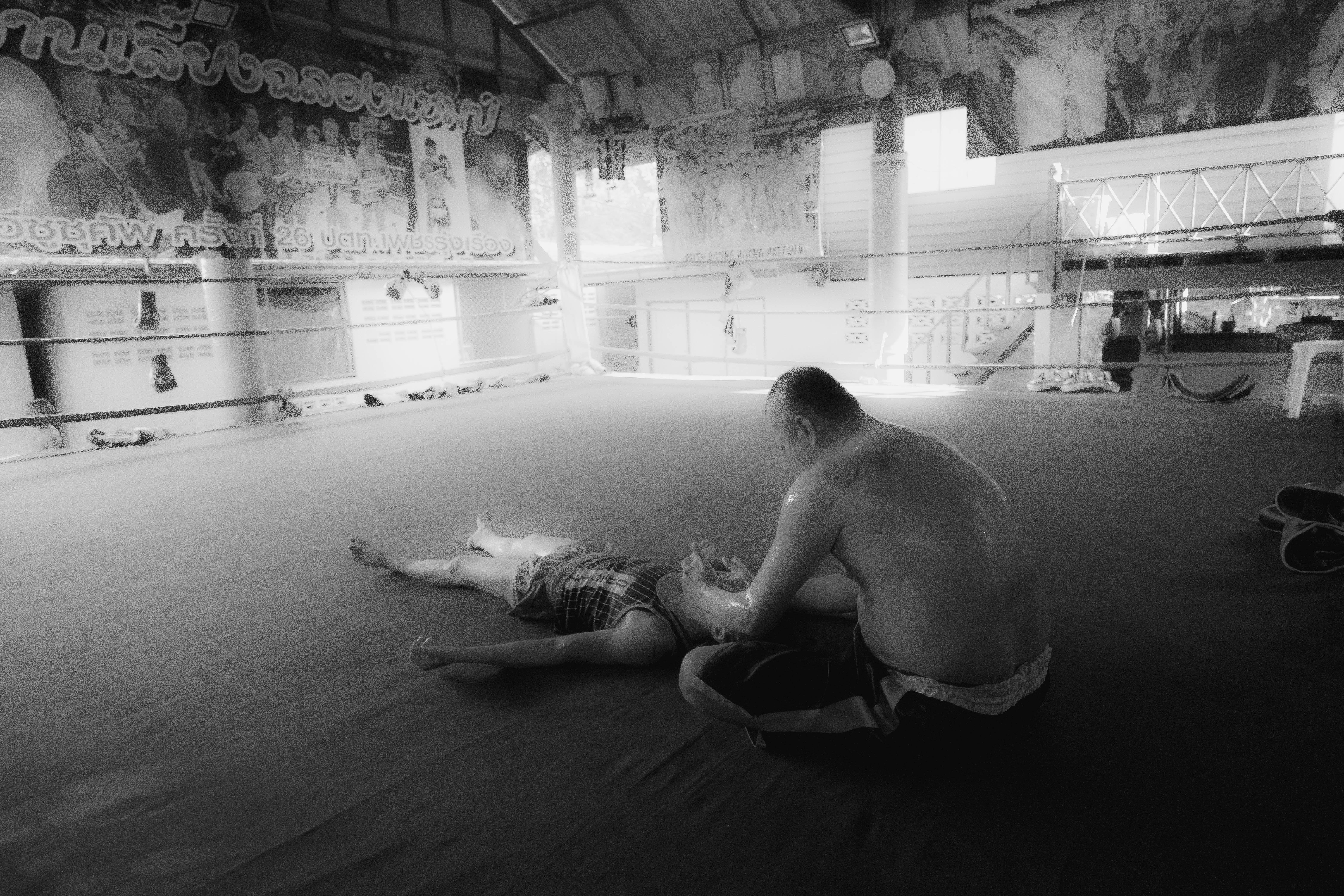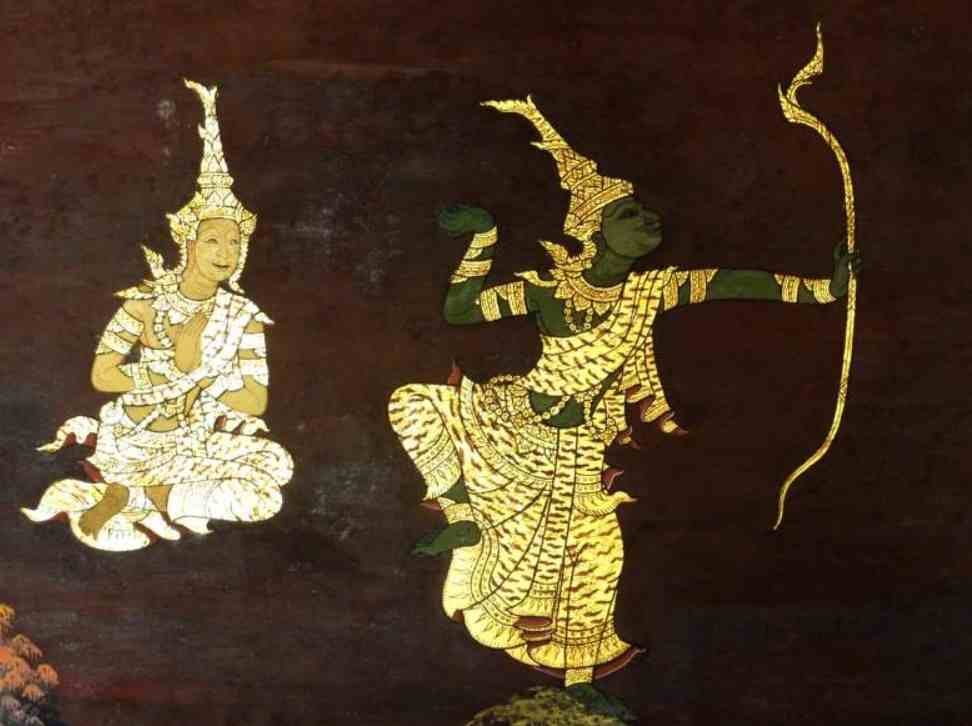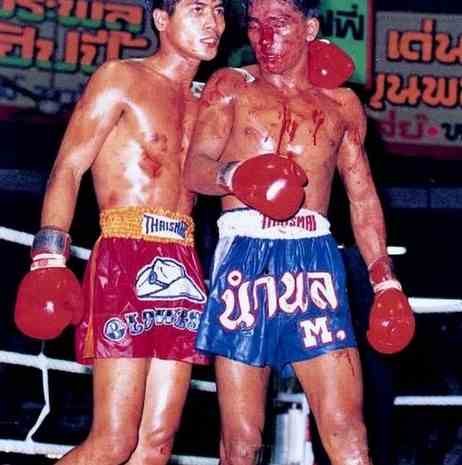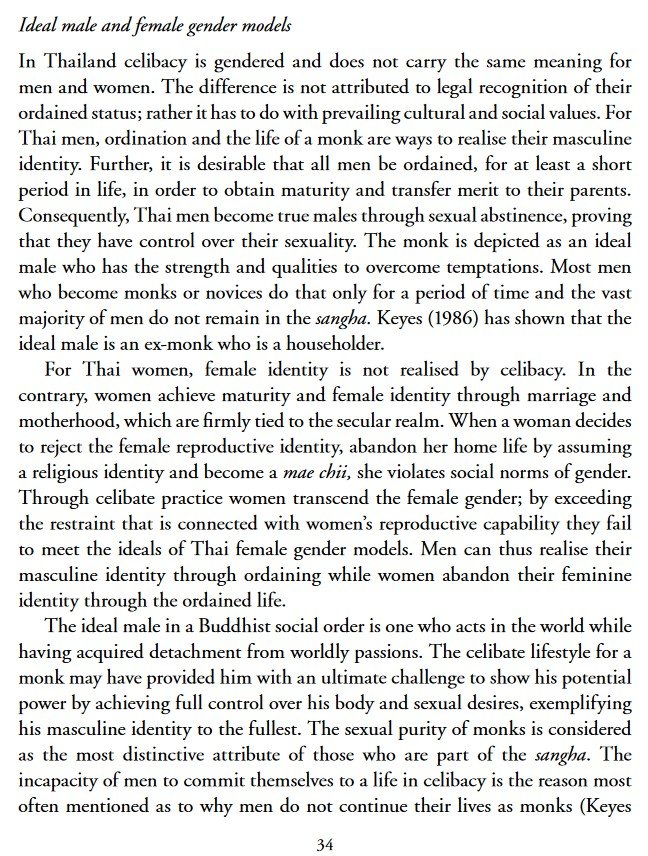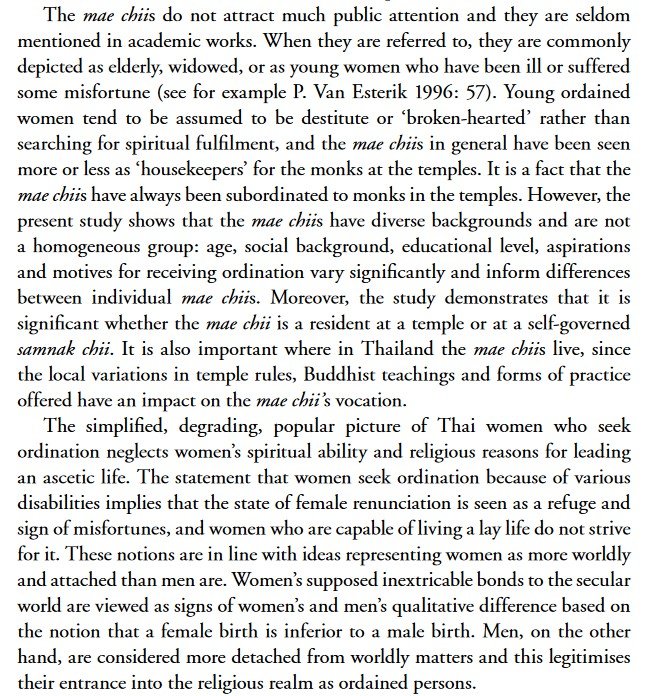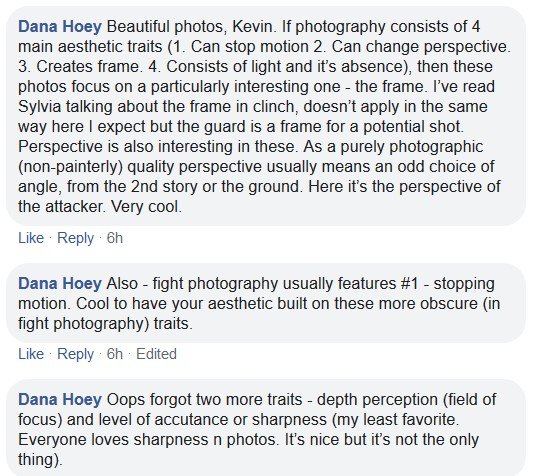-
Posts
2,264 -
Joined
-
Days Won
499
Everything posted by Kevin von Duuglas-Ittu
-
I would be wary of the opinions of the East from a 19th century European, who had his self-centric problems with race and stereotypes, to be sure. This does sound pretty reductionist to take his lead, but it certainly is a line of thought as well. Nietzsche probably knew very little of the lives of actual Buddhists, and all of it filtered through the prism of ideology. There is an ascent being performed in the Buddhistic ideals of self-mastery I would insist, which are reflected in the scoring asethetics of Thailand's Muay Thai. The artful matador is ascending over the bull, in one way or another. The bull of the Other, or the bull of oneself. The bigger debate seems to be about the bull. The bull is both blind instinct, in the cul-de-sac of its circuits and drives..."dumb", and also the progenitor of its own brilliant, un-guidable Becoming (...perhaps). This Self-Mastery, owned in the Buddhist ideal, is a potent path. I remember talking about Samart with Krongsak (a powerful, forward-fighting, Muay Maat fighter who drew with Dieselnoi). Krongsak nearly spat out disgust over the very accomplished femeu fighter Robert of JockyGym. All he does is run. He's not even a fighter. Its as if he was saying, he's not even a man. But, when he turned to Samart his eyes melted. For Thai fighters of the time nobody moved like Samart. Nobody existed in the space like Samart. He just shook his head in awe. (He also humorously said, when asked who would win between Somrak and Samar, "What promoter would book that fight? Who would pay a ticket to fall asleep!"). I'm just saying that if we are really going to get a handle on this dichotomy you can't reduce this incredible beauty of Samart, the femeu ascension, to just a "civilized slave morality". This is a performed transcendence that was very real in terms of violence in the ring. We have to account for the effect of Samart...or, you can replace Samart with someone who is even an more interesting aesthetic fighter, Karuhat. I realize that you are just free-wheeling in associations and ideas, which is, after all, where lots of good perspectives can come from.
-
One should say, also, if talking about the archetypal dichotomy of Muay Khao and Muay Femeu that many Golden Age Muay Khao fighters will really complain about the clinch fighters of the present era. They will complain how the game has become just a strength game, that all the art (femeu) has been lost in Muay Khao fighting. So the carriers of the High Art of Muay Khao, who themselves were demoted in the ideological pairing, use the same qualifiers to complain about the Muay Khao fighters of today. I'm not saying it isn't a fair criticism, it is for real and accurate I believe, but it is ironic to hear legends of the sport who were downgraded, aesthetically, use the same ruler to measure the next generations.
-
This. Totally. What is so interesting is that for decades now, with the fight lost to history, Samart losing to Dieselnoi was but a blip in his career. But when the actual fight video surfaced you see Samart being basically destroyed by Dieselnoi, totally overwhelmed in a way that had never been recorded before. Samart's sheen of the undisturbed fighter completely fell off. Before that video surfaced it wasn't even questionable who the GOAT was, but then it became questionable. Yes, you see the size difference, but you also see the art in Dieselnoi. And you see that Samart performed much worse than, say, Chamuakpet did facing even greater size differences like Sangtiennoi. The entire "story" of femeu inherent superiority falls away a bit, like a myth, because honestly the only people who saw that fight in the stadium, actually saw what happened. The aftermath of that fight, one would think, would have catapulted Diesenoi into GOAT status, the Muay Khao becoming proved itself, it won the eternal battle. But instead Dieselnoi said "No one would choose to have my life". Samart went into further glories, then movie roles, singing performances. The princely becoming continued its ascent. One cannot also, in this dichotomy escape the real sense that the poor and rural lay on one side of the Becoming divide, and the educated, urban, cosmopolitan on the other. It feels as if a myth is at work. An eternal myth? Or a particular ideological one? There is a very interesting gendered quality to Muay Khao vs Muay Femeu, in how fighters (and probably fans) think of it. Dieselnoi will joke and giggle, saying "Samart hits like a girl" (they are very, very good friends). I recall Samson Isaan, when he filmed with Sylvie with Karuhat present, would imitate a Muay Femeu fighter, dancing away like a girl, waving goodbye in an effeminate way. The "art" of Muay Femeu can contain strong feminine overtones when parodied. To the old school Muay Khao fighter the Muay Femeu fighter is not manly. While Karuhat would then make fun of Samson, pretending that if they fought Samson would just keep stumbling and falling, tripping over Karuhat's deftness, like a dumb man. There is an amazingly gendered (and also class) quality to this. But, going back to the original point of the post, women, female fighters, do not have access to this "feminine" (or maybe androgynous) ascension, by virtue of their sex. Female Thai fighters tend to adhere to the Muay Femeu aesthetic, for just this same gendered aspect, but it lacks transcendent powers for them. That's a really interesting thought. Maybe? I mean, they definitely appreciate the comeback, when it happens and succeeds, but there is a certain stench of desperation in even the attempt. A sense of shame, I think. Part of this though is that, for instance, in America and other mythologies of the Self, social mobility is highly encouraged and celebrated. The individual is cut free from the fabric of his/her conditions. Whereas in Thailand and the karma of community and rebirth, there is no such thing as the "self made man". Social mobility is quite rare on the whole. Facing a 5th round where you find yourself well behind in a fight, is a condition you have made for yourself, and I think there is a kind of embrace of that that creates a dignity, at times.
-
Yes, I would in no way suggest that Muay Femeu is reactive. The matador leads the bull. The whole point of Thailand's scoring biases is to affirm the control and dominance of artful imposition. What is interesting is that the classic pairing Muay Khao becoming and Muay Femeu becoming are in tension with each other, but also rest on a hierarchy of ascension. What is one to make of this really ideological and even politicized hierarchy? Is the Muay Khao fighter necessarily "lessor", and if so, on what anchored basis? I like this.
-
Here is the great ideal hero Rama (Vishnu) in the Ramakien, perfectly balanced as if in repose, firing his deadly arrows. This is Samart and his dangle-arms: How does one balance out, or rectify the continuous becoming of Dieselnoi, that tragic joy of affirmation, which counters the "beast mode" of negation, and the Princely cancellation of "beast mode" clashing, found in the elevation of Samart and figures like Rama? Are these the twin, and perhaps irreconcilable philosophies of Transcendence and Immanence? In this famous photo of Samart and Namphon, you have the princely transcendence of the future movie star Samart, and the bloodied Muay Khao man from a small Isaan town, cut by "intelligence" and "art" (I use these descriptions to bring out the dichotomy of judgement, not because they are real or fair). Ironically enough, Namphon's little brother Namkabuan would go onto to somewhat fuse these two aesthetics, the handsome, dashing technical fighter, and the relentless, explosive Muay Khao stylist: Interestingly, when we talked with Samart he told us, quite proudly, "I have never lost to Muay Khao" (despite losing quite dramatically to Dieselnoi). These are very loaded and powerful aesthetic judgements.
-
I can really buy into this at a kind of fundamental level of philosophical critique of the west and "beast mode" negation. But...I might have some difficulty making the pure equation between "chon" and affirmation. I mean, when you write: This really communicates a great deal of what you can FEEL off of Diesenoi when you are right there in his presence, to this day, a kind of tragic joy of affirmation. It's incredible. But, in Thailand there is also a kind of laddered critique of "chon" that is built into the scoring aesthetic, and the ultimate eternal battle between Muay Khao (chon, the bull) and Muay Femeu (su, the matador). What is so incredible about the Samart vs Dieselnoi fight, and finding it after all these decades, was how definitively the Muay Khao fighter just dismantled and broke the illusions of control of the fighter who is otherwise regarded as GOAT in style. In Thailand the Muay Femeu fighter, all things being equal, will always be more esteemed than the Muay Khao fighter. As Thais may say: Animals "chon" (clash), humans "su" (fight). So while there is a kind pan embrace of fighting "chon", there is also a scale on which it is judged. I always think back to this fight between Samart and Namphon. Namphon was one of the better Muay Khao fighters of his day. We have only a highly edited version of the fight, but from this fight edit it is almost impossible for me to see where Samart won this fight. It is clear that he did, you can see the frustration and resignation on Namphon's face, but it looks like Samart just "dangle-armed" his win. He went into a theater of play and superiority, and this theater (and his reputation) just stole the show. (You can see Samart trying to do these same dangle-arm tactics in his loss to Dieselnoi and his final fight vs Wangchannoi, but where they just appear as lost attempts at dignity): Samart in some ways is Vishnu, the conquering god who does not break a sweat, who with his lazily flung destructive arrows vanquishes demons. He embodies the "Bangkok" courtly Muay Thai that claims almost moral superiority to the Muay Khao, lower class clashes of the Muay Khao fighters of Isaan. He is princely. Almost all Muay Khao fighters have to fight against the stigma of just being "chon" fighters (low IQ, super strong and enduring, work animals). Dieselnoi has to explain how he was an accomplished, strategizing fighter. Chamuakpet is named "Mr. Computer Knee" to emphasize his intelligence. Elbow fighters have to use elbows artfully, and not with too much force or repetition (this is one reason why Yodkhunpon's career is vastly under appreciated by Thais, because he didn't). All of this is to say is that as much as Thailand celebrates a "chon" of fight culture, and an incredible tragic joy of affirmation, it also has a parallel path, a secondary channel, which overlays a story of transcendence, which also is quite hierarchical, political and ideological. But, you see this not just in Thailand or Muay Thai. The same thing played out between the "working man" Joe Frazier and Ali in western boxing.
-
There is an additional observation or note when taking up the maturation process of Thai boys through Muay Thai, and monkhood regimes of self-control. And that is if we take them to be parallel developmental paths, it perhaps sheds light on something that has always mystified me. Former fighters who fall to drink, who become alcoholics, have serious social stigma attached to them, even from within the community. As a westerner this just strikes me as just another vice, common among any in the population...but alcohol in particular seems to have an excessive strain to it. For a long time I just took this to mean that alcohol in its history in the culture just developed certain associations. There are legends of the sport who just became slotted very low, socially, because of their functioning alcoholism. It never quite added up. But, if Nak Muay are held up and esteemed, in the art, in part because of the very same self-control values that monks are idealized with (by degrees), then the fall from grace, the contrast of control vs a lack of self-control, just might really feel morally stark. We think of these great fighters and are like: How can you forget with they were!? (and in a way, still are). But, if you had a great monk who then at a certain point didn't abstain from celibacy in a vivid way, you really would not be thinking back to what a great monk they once were. Instead you would just get a very strong feeling for the depth of the fall. I'm not entirely sure about this, but it does lend itself to this analysis of value through displays of self-mastery and control. And the social shame that comes with falling from those states.
-
I know you are being cheeky, but just to be clear, it isn't actually the adult language, it's the part that begins.... Usually, anything that begins "not trying to be an asshole" and then follows with profanity, well...you know, is lacking in tone. I'm just trying to keep it all cool. If you want to cuss, curse, bust out all kinds of language in a friendly way, go for it. Sylvie and I are pretty sailormouth when it comes to enthusiasm.
-
To add to what Sylvie is saying: But, they are connected, because when your body folds, you can appear affected even if you don't show it on your face. So being really aware of your ruup, or disciplined in it, can help you appear to be ning. You can still be ning if your body folds, just in how your play it off, your continuity, your energy, not becoming mad, showing pain, or being hyper-aggressive (emotional control), but having great ruup supports the sense of ning.
-
I really hesitate to jump in here because you and I have very different frames of reference, and a great deal of what you assert just doesn't jib with what I know and experience, but I might as well give it a try... this just isn't what padwork is, or is for in Thailand. Yes, gyms that handle a lot of westerns do start molding padwork as a kind of simulated fighting...because they are westerners, and they often lack basic rhythm or responses...and, importantly, westerners like it. But this just isn't what padwork is for in the building of Thai fighters. Padwork, originally, was designed to "charge the battery" (as Kaensak put it) leading up to a fight. It's pounding out fighting shapes, building endurance and explosiveness. It isn't really a "teaching" mechanism. It's kind of become one for westerners, because gyms are changing, but this isn't what it really is for. Thais don't need to "simulate sparring", well, because they spar. If there are any teaching, or leading aspects of padwork, traditionally, maybe for developing fighters its about rhythm, posture, constancy, spacing, in the exercise of power and endurance. No, padwork really isn't "simulated sparring", at least in the core of it. Westerners do experience this "simulated fight" quality in Thailand, and then bring it back to their gym and mark it as "very Thai". And, I do think that for westerners who do need a lot of developmental experiences, it's a very good thing to try and bring out the "fight" energy in their Thai trainer, who usually is an ex-fighter and probably pretty bored with their endless rounds. Its a very good thing. It's more fun, etc. But no, that isn't really the purpose of padwork, classically.
-
I really don't mind the turn to metaphysics here! And I like how you picture "beast mode" as a negation, while traditional Muay Thai as an affirmation. There is something genuinely Dionysian I think about Thailand's traditional celebration of the art (and I suppose something of Apollo of course). It is that ascending spark, through the hierarchies of Being, or at least it feels like that. It is no accident that a Muay Thai fight begins with a dance.
-
Ali played a lot with "just looking tired" in an exaggerated way, to buy himself time to rest, or to create dramatic reversals when he really hit the gas again. Instead of tired, great femeu fighters like Samart or Somrak instead look disinterested, or like they aren't fighting hard. They still have ruup, in the sense that they aren't staggering around, but instead they make it all look like it is effortless, and nothing is effecting them.
-
To follow more some of the essential idea proposed here, the study trades on the dichotomy or contradiction in that the spiritual emptiness and non-attachment of Buddhistic practice necessarily goes beyond identity (which is attachment), and therefore gender. The aim itself is toward genderlessness, while the social conventions which structure that practice are quite gendered and hierarchical. I would suggest that the very same thing exists in Thailand in terms of fighting. Thailand has a Fight Culture which celebrates fighting, or "chon" (clashing) in a pure sense. For this reason men fighting, children fighting, women fighting, chicken fighting, and even beetle fighting all participate in the same essential thing, the chon of spirit. You can check out Sylvie's articles on Bettle Fighting in the North to see aspects of this: Muay Thai Clinch is Not Boring – Gwang Chon – Battle Beetles of Thailand - Part 1 Underground Gambling, Beetle Fights, Heart and the Clinch of Muay Thai - Part 2 These transcendent views are really part of the way in which Thailand can be very freeing for western female fighters. There is a real sense in which female fighters are just part of the chon of a universal spirit of battle, and that as long as the spirit is exhibited, it is celebrated. A nexus point in a possible comparison between Thai Maechi and Thai Nakmuay Ying is the way in which there is an operative transcendent, gender-less apex of celebration, something which unites all participants, but also, a hierarchy of laddered social striation which can lead both also unreadable, or at least very hard to read.
-
I'm reading a really informative and well-written study of the Maechi (or Mae Chii) of Thailand, MAKING FIELDS OF MERIT Buddhist Female Ascetics and Gendered Orders in Thailand, you can download it here (300+ pages): MAKING_FIELDS_OF_MERIT.pdf It details the field study of a class of women in Thailand who have devoted themselves to religious pursuits, vowing celibacy, taking on the ascetic life. They are often referred to as "nuns" in rough cultural approximation, and exist in a kind of no-mans-land of social status. Women cannot ordain as monks (Bhikkhunī) in Thailand, even though historically Bhikkhunī existed for centuries after Buddha established the order, largely due to a much argued over technicality in the laws of ordination. I'm not hear to discuss that dispute, but rather draw an compelling parallel between the struggles of religiously devoted women in Thailand, the female fighters as well. I am not making these equal ambitions, but suggesting that this study draws out facts about the Maechi struggle that shed light into the nature of Muay Thai and the deeper social significance it plays in Thailand's culture. In making the Maechai situation clear, some aspects of gendered Muay Thai also become clear. I'm going to try and cut to the chase a bit, and not build out too much context. Maybe more context can be added in responses, or in a coming Muay Thai Bones podcast where it might be great to discuss this with Sylvie. I'm going to focus my thoughts on just two short passages. The first describes the "Ideal Male" in Thai culture, in the context of expected short terms stays in monk hood by most males in the society. And the second speaks of the dismissive position Maechi find themselves in, having renounced worldly attachments and devoted themselves to religiosity. On the Ideal Male The key sentence for me is the last sentence of the first paragraph. The "ideal male is an ex-monk who is an householder". In the flow of society, the ideal male proves his ability to abstain, to have self-control --- for a short period of time --- than then assumes the householder position having proven, or graduated into adulthood. It is important that the author is making a kind of discrimination of what "ideal" means. In the stronger sense of ideality, monks in their life long self-control, form the ideal, but in a more connotative, practical sense, it is the process of touching upon that ideal, and then taking your place running a household, that is the ideal. On the Non-Ideal Female Here is where it gets really interesting, and indeed painful. While striving toward what one would assume is a genderless Buddhistic ideal, non-attachment and religious devotion, Maechi are actually downgraded and cast as social failures. They are, by a stereotype, heartbroken or destitute in some way, falling out of their gendered role, and simply taking the refuge of Buddhism (ironically enough, in the pledge you make to convert to Buddhism in Thailand you are asked to take the Sangha,the "Church" so to speak, as your refuge). While men are lauded for their self-control, even for a short period of time, Thai women can be doubted and even side-glanced. The Maechi and Nakmuay Ying This double standard as to devotion to self-control commitments, and assuming social roles plays out in very suggestive way when we shine the same light onto Muay Thai, not just as a sport, but as a social art of self-cultivation and individuation. To understand more on how the Nak Muay personifies some of the same values and experiences of monkhood for Thai boys and men, read: Thai Masculinity: Postioning Nak Muay Between Monkhood and Nak Leng – Peter Vail. It's enough to say that one of the main fabrics of Muay Thai, not only in it's aesthetic, but also in it's core coming of age experience, of boys becoming men, is the hypermasculine way it asks a fighter to embody self-control. This falls directly in line with the ideal of masculinity expressed in the passage into monkhood by Thai men. (And this is one reason why international kickboxing inspired "beast mode" fighting aesthetics being projected onto Muay Thai in Thailand are so painfully tearing at the very meaning of what Muay Thai is.) In any Muay Thai gym in Thailand that is raising young Thai fighters you are witnessing the same self-control project that is expressed through monk hood. In monk hood this self-control is perhaps quite widely stereotyped as sexual desire (though it is much more than this, of course), in the Nak Muay it is controlling the extremes of emotion (anger, tears at loss or physical pain, overt pride). These are both projects of control. Control yourself, then become a man. Young teen Thai fighters are also often denied girlfriends, and one of the reasons why females were kept out of traditional gyms is likely related to this same "self-control" project of personal transformation. The question I'm opening up is found in the rough parallel between the fact that the same self-control project when taken up by Maechi (Thai female religious devotees) is not taken up as admired, or in some important sense of even having a home in society. Often the Maechi are seen as a kind of celibate "wife" of monks, cooking and cleaning at the temple. Her devotion to one of the highest, and theoretically genderless aims of human existence (which at the face of it will be admired in the abstract), becomes in a sense, unreadable. Part of this is there is no place for it. Women cannot become Bhikkhunīs (monks). They cannot take the place of recognition and institutional support that would make their devotion readable to the people. And, I hope this does not appear as too much a stretch, but Thai Nakmuay ying cannot fight in (or even touch) the National Stadia of Thailand. Thai female fighters can devote themselves to not only acquiring the skills and experiences that make them the best fighters in the world, but also steeping themselves in the same social conditioning, submitting to the same "self-control" inculcation that turns Thai boys into men, as Nak Muay - but, their accomplishments ultimately become unreadable against the backdrop of gender role expectations, in the family. The values of self-control that make up a great Muay Thai fighter in Thailand indeed become esteemed and admired, whether they appear in a young male fighter or a young female fighter, just as a devoted female meditation-ist, or a male meditation-ist would be esteemed and admired, but for each vocation there is no readable place for the female devotee to graduate to. There is no Lumpinee, there is no monk hood. And the reason for this, ultimately, is found in the way that Thai women are asked to relate to their desire, and the role it plays in society at large.
-
A few things about that fight. 1. ONE calls what they put on "Muay Thai", but it isn't Muay Thai. It isn't reffed like Muay Thai, nor scored like Muay Thai. It is sad that it is becoming a layman's reference for what Muay Thai is, around the world. I say this well beyond this fight. 2. I like Ramazanov a lot, for a non-Thai. To be sure. But he's just doing memorized switch steps advances and patterns over and over and over. It isn't really fighting, using your eyes, like any top Thai fighter does. There is no solving, no thinking, no seeing. It's hold your breath and throw your pattern, move. Hold your breath, throw your pattern and move. This is just not "fighting" in my view. 3. Petchmorakot is not near his prime. I didn't know his career when he was at Lumpinee, but at 25-26 and with the way he fights not really an accomplished fighter at this point. I know ONE wants to hype him as such, but he's just an uncomplex Muay Khao fighter, with very simple attacks. ONE likes to feature and hype fighters. Fighting outside of his career prime, and outside of stadium rules and judging makes him un-extraordinary. 4. Ramazanov in that fight didn't even understand how to close his open side to a southpaw. This is really something any 10 year old in Thailand knows to do. It's basic Muay Thai. If he had simply checked the rear kick, Petchmorakot had nothing. The absence of even basic defense vs southpaw just points up to serious deficits. 5. There is no way that Ramaznov wins that fight in full Thai rules. You don't get "points" for throwing a lot (you actually will lose points for it). The announcers themselves didn't even seem to understand Muay Thai rules proper. 6. An exciting win for Ramaznov, to be sure. Something to be proud of. 7. I'll repeat. It's sad that hybrid-ish representations of "Muay Thai" such as ONE are becoming representations of what Muay Thai is. I say this as a Ramazanov fan. I love watching him vs other non-Thais. But what I see him doing isn't really "Muay Thai" to me, or vision guided fighting. I never want to put a coach in a position where they feel like they have to defend or justify their training methods. Sounds like you've come upon a great compromise in making things work with what is available.
-
I'm very torn on this. I am 100% opposed to drill based fighting teaching, I think it's a cop out. Yes, there is a place for drills to be sure, and Thais indeed drill basics in the very young, but there is no expressive sport in the world where the elite, poetic fighters became that way primarily through drills. I say this though fully knowing that the west HAS to drill. It's in the very fabric of the business model of teaching. Drills are essentially mechanical abstractions of a living art, exported from that art, and put into an assembly line of a kind. Yes, the assembly line can and does produce working models of something, just like it can produce cars, or widgets, but the very act of abstraction, of mechanization for the purposes of duplicaiton, is killing the art of what Muay Thai is...in my opinion. As I say though, the west simply has no choice. It's like having to teach people how to play baseball in a land where no baseball fields exist. You can learn all kinds of "things" done on a baseball field, but if you don't have baseball fields you'll never really know what baseball is, or really have ever played it.
-
I like the way you put that. But...it should be thrown in there, often pretty huge weight advantages. Giving a power puncher 15 lbs or more in the ring is kind of what helped lead to that exaggeration. Give him a 10 lb disadvantage regularly and all those memorized combos would become fluff. I totally agree though that there is a serious challenge in teaching in the western context for Muay Thai coaches, and their gyms. The funny thing is though...it doesn't seem to have prevented the western world from producing some of the greatest fighters ever in terms of boxing. I really think that the problem is one of class. Boxing took its roots in the lower classes, and widely so, where fighting and its processes means something very different from the more usual middle class and even upper middle class targets of many western Muay Thai teaching scenarios.
-
This post cannot be displayed because it is in a password protected forum. Enter Password
-
Also The Camp in Chiang Mai, which is pretty expensive, but nice facilities I think will arrange a Language ED visa for clients. I'm not sure this is anything you can't do for yourself, but it is something I think they promoted this in their description: https://www.facebook.com/thecampmuaythai/
Footer title
This content can be configured within your theme settings in your ACP. You can add any HTML including images, paragraphs and lists.
Footer title
This content can be configured within your theme settings in your ACP. You can add any HTML including images, paragraphs and lists.
Footer title
This content can be configured within your theme settings in your ACP. You can add any HTML including images, paragraphs and lists.
